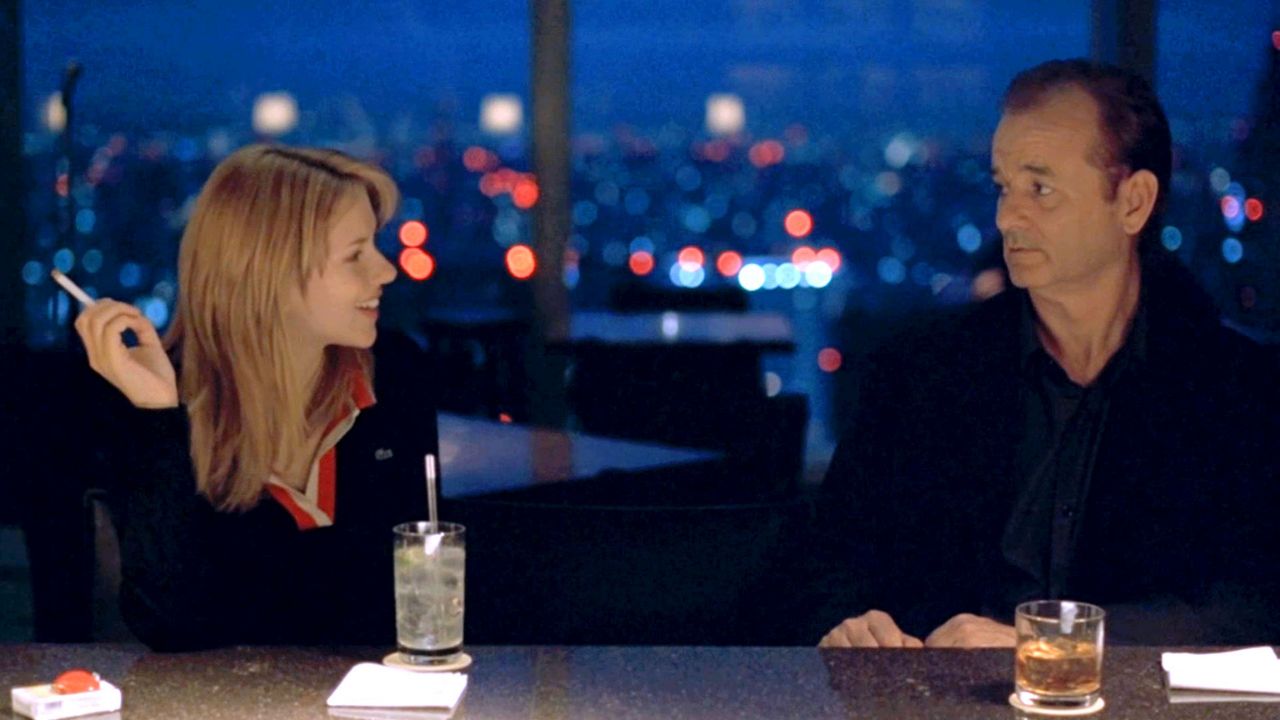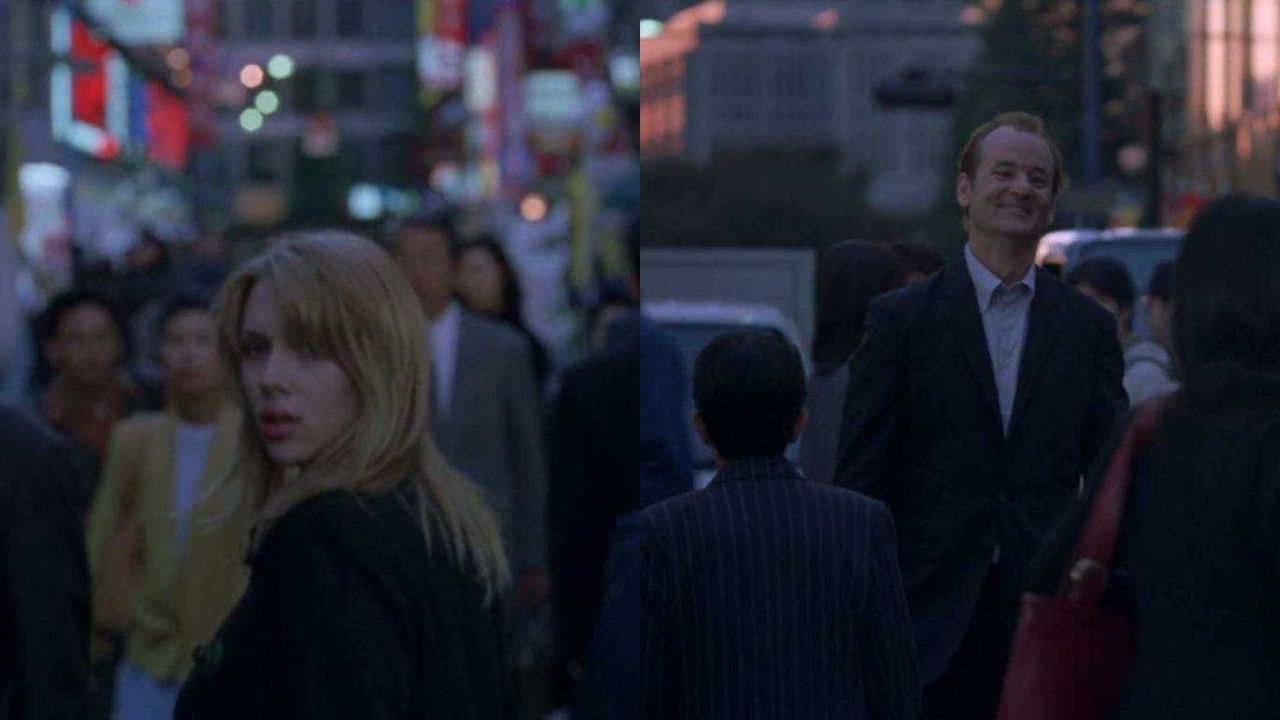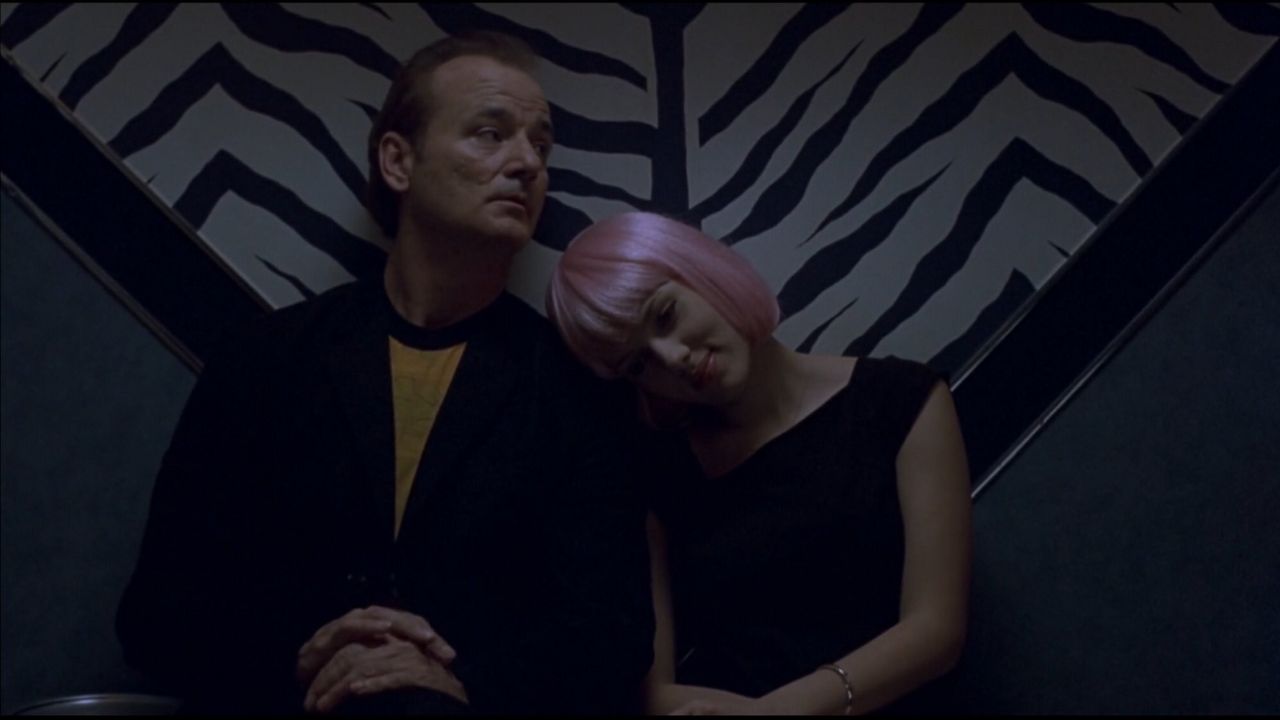This post includes a brief plot summary and an explanation about the ending of the film Lost in Translation (2003). Beware of spoilers.
Directed by Sofia Coppola, Lost in Translation (2003) is a drama starring Bill Murray as Bob Harris and Scarlett Johansson as Charlotte.

The film “Lost in Translation” is about two strangers (Charlotte and Bob) who cross paths during their stay at a hotel in Tokyo. Bob is an actor who is currently shooting an ad, and Charlotte is a recent graduate. Together, they explore the city and soon develop an intimate bond that helps them cope with their personal struggles.
What Is Going On in “Lost in Translation” (Plot Explained)
The protagonists of “Lost in Translation” are in very different stages of their lives. Bob is a middle-aged man who was once a movie star. The actor is currently in Tokyo to collect a lucrative paycheck from a renowned whiskey brand. Meanwhile, Charlotte is a young woman who spends most of her days at the hotel while her husband is working.
Bob and Charlotte often seek each other’s company and exchange confessions. At the moment, Charlotte feels somehow out of place. The young woman is uncertain about her future and her marriage. Bob also shares some of her personal struggles. At the moment, the actor is having problems with his wife and is unsure about the direction of his career.
One night, Bob has one too many drinks and ends up having a one-night stand with the hotel jazz singer. The next morning, Charlotte knocks on Bob’s door. Tension arises between the actor and the young woman. Nonetheless, they eventually sort it out. Meanwhile, Bob informs Charlotte that he’ll be leaving Tokyo soon.
The Ending of “Lost in Translation” Explained
The ending of “Lost in Translation” shows Bob and Charlotte saying goodbye before he leaves the hotel. During his ride to the airport, Bob spots Charlotte on a crowded street. The actor tells the driver to stop and gets out of the car. When Bob finds Charlotte, he gives her a hug and whispers a couple of words into her ear. In the end, they share a kiss and bid each other farewell.
“Lost in Translation” is a highly subjective film, therefore, there are many possible interpretations for the ambiguous ending. Some view the film as a love story between two alienated individuals who find each other in the busy city of Tokyo. Others view “Lost in Translation”, as a story about two strangers who develop a strong friendship in an unexpected place.

One of the most prevalent questions about the film is, “What does Bob whisper to Charlotte at the end of Lost in Translation?” The audience never learns what Bob whispers to Charlotte at the end, but given Charlotte’s reaction, it must have been a message of comfort and hope.
Bob is aware that Charlotte’s life is currently filled with doubt and uncertainty. But from his experience, everything will eventually find its way. That’s what life is about, one just needs to keep moving to figure things out, which is the meaning behind the ending of “Lost in Translation”. Also, the final kiss between Bob and Charlotte is a symbol of their genuine and intimate connection.
Many like to describe “Lost in Translation” as a romantic comedy, but personally, I just don’t see it. There is indeed a strong emotional bond between the leading characters of this story, but their connection isn’t necessarily romantic. They were just sharing personal insecurities in a similar way that close friends do when they are seeking emotional support. Therefore, in my opinion, the final interaction between the protagonists was not a romantic kiss.
Lost in Translation Discussion
The film “Lost in Translation” explores themes such as loneliness, alienation, and a lack of direction in life. Both protagonists are plagued by feelings of loneliness despite being surrounded by people. Not only that, but they also experience an incredible sense of alienation. Bob and Charlotte are two Americans in a foreign city. The language barriers and cultural differences amplify the protagonists’ feelings of disconnection from themselves and their surroundings.
Throughout the film, Bob and Charlotte navigate through their personal struggles in a city that they barely know. The uncertainty of their future and the lack of a general purpose in life lead the protagonists to feel adrift. In a way, Bob and Charlotte are floating through life without a clear direction.
In each other, Bob and Charlotte find solace. Over time, the two develop an intimate bond. They achieve a certain sense of liberation when they exchange their most personal fears. Something that Bob and Charlotte haven’t been able to do with their own significant others. Although they had to part ways in the end, they will always have the memory of having met each other.
The story of “Lost in Translation” reminds its audience that there is beauty in the unknown. Bob and Charlotte were two complete strangers who formed a close connection in the most unexpected place ever. Also, being with someone for a long time does not equate to knowing them. In a short period of time, Bob and Charlotte learned more about each other than their significant others ever did.

“Lost in Translation” conveys the message that it is okay to occasionally feel lost. Sometimes, life resembles those busy Tokyo streets. People are moving, sometimes they make a connection, and other times they just pass by. Bob and Charlotte are two individuals who crossed paths and had a meaningful moment together.
The Problems in “Lost in Translation”
Despite being a refreshing film about human relationships, “Lost in Translation” also has its share of problems. So what is the problem with “Lost in Translation”? Sofia Coppola’s film perpetuates certain negative Asian stereotypes and “normalizes” certain racist attitudes coming from the protagonists.
The infamous “black toe scene” is one of the finest examples of the problems mentioned above. In this particular scene, Bob and Charlotte are having lunch, and she shows him a bruised toe. Everything mentioned thus far is pretty innocuous, but problems arise because of what happens next.
After taking a look at Charlotte’s injury, Bob keeps making funny remarks about her “black toe”. However, the jokes do not stop here. Bob proceeds to also make fun of the sushi chef and comments how some Japanese people love a “black toe”. For some, the remarks might sound funny and quirky, but for others, they might come off as a bit racist.
Personally, I don’t think the racism is in what Bob said, but in how he said it. As I see it, Bob’s whole attitude during the “black toe scene” was just rude and ignorant. Now, I don’t think Sofia Coppola is trying to glorify the racist attitudes of Americans in foreign countries, but viewers shouldn’t be watching these scenes and believing that it’s okay to behave like that.
Final Thoughts
As I said before, “Lost in Translation” is one of those films that has no shape, it becomes whatever the audience wants it to be. And I’m sure that’s not everyone’s cup of tea. Nonetheless, the film’s subjective nature is also what makes it unique: the viewers will either get it or not.
In my opinion, there isn’t a right way to interpret a story like “Lost in Translation”, which is what makes it so fun to watch. For me, “Lost in Translation” was about two people who lacked a general purpose in life.
For others, “Lost in Translation” might work as a metaphor for depression, which is often characterized by a sense of loneliness and inexplicable sadness. Depressed individuals often experience a sense of disconnection and an inability to enjoy the present, which might lead them to feel lost.
My feelings about “Lost in Translation” have changed over time. When I was younger, I enjoyed the film for its atmosphere and not so much for its plot or message. At the time, I found the characters and their emotions more relatable. As an adult, I find “Lost in Translation” sometimes borderline racist and somehow privileged.
Seeing Tokyo through the leading characters’ lenses was like reading through someone’s personal diary. Having said that, the Tokyo shown in the film might not be an accurate representation of the city. It’s the director’s interpretation of Tokyo, which is tinted with her own bias about the city.
Despite some of the negative observations, I still think “Lost in Translation” is a good film. Bill Murray and Scarlett Johansson gave the audience very believable performances as Bob Harris and Charlotte.
“Lost in Translation” is a film that celebrates the beauty of human connections, even when they are brief and imperfect. In addition, the film challenges its audience to wonder about their own place in the world and what they are looking for. Overall, “Lost in Translation” is an interesting tale that offers a unique view on life, love, and loneliness.


